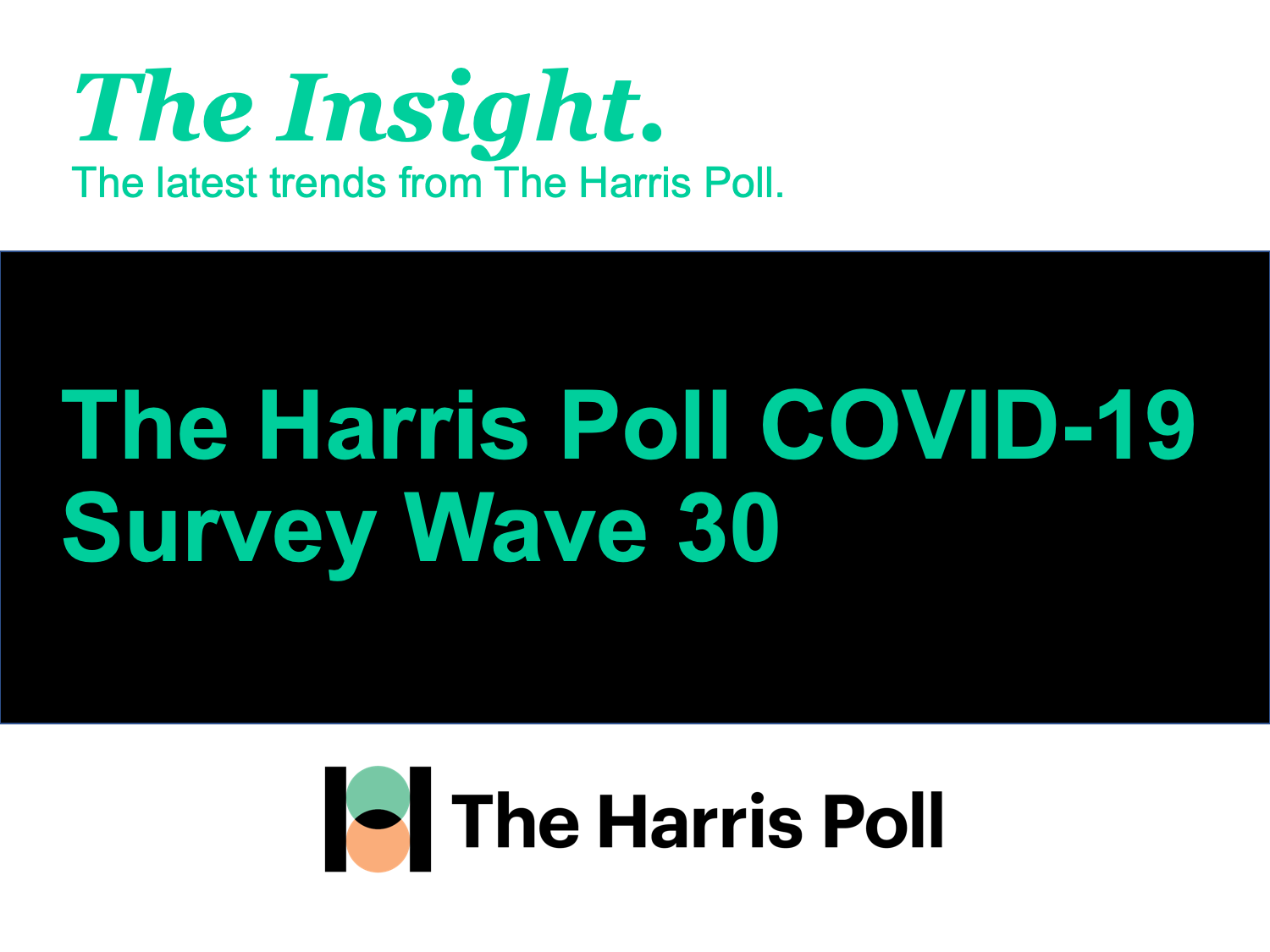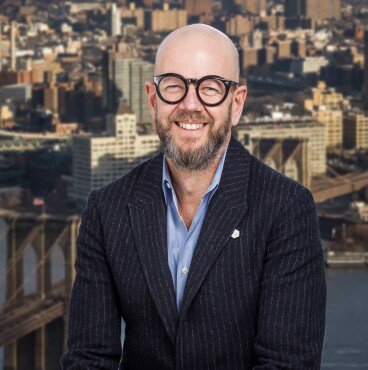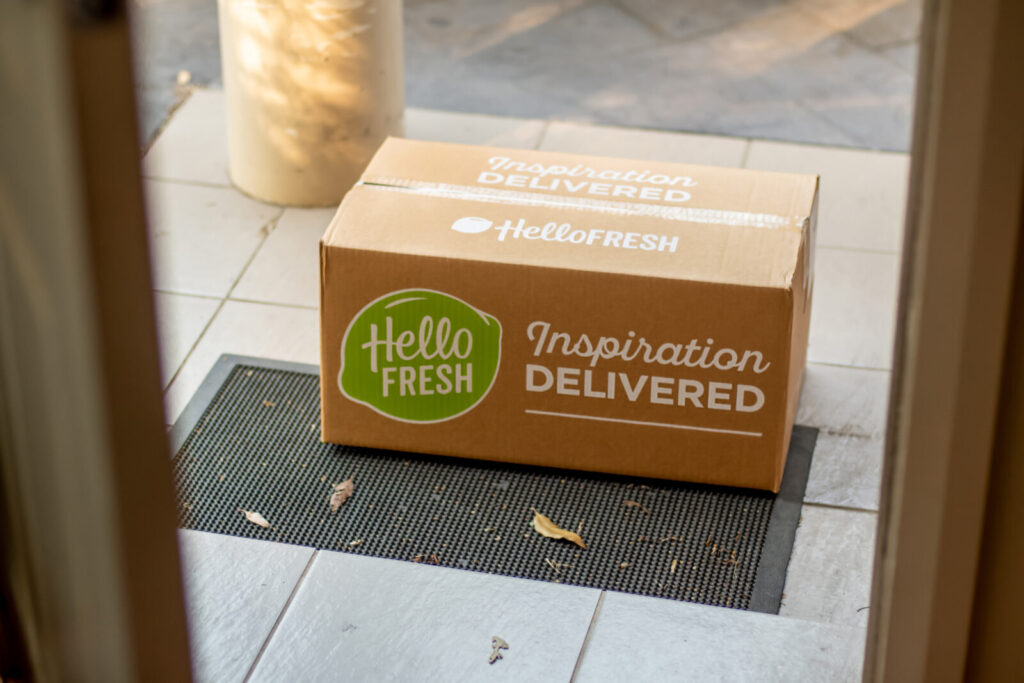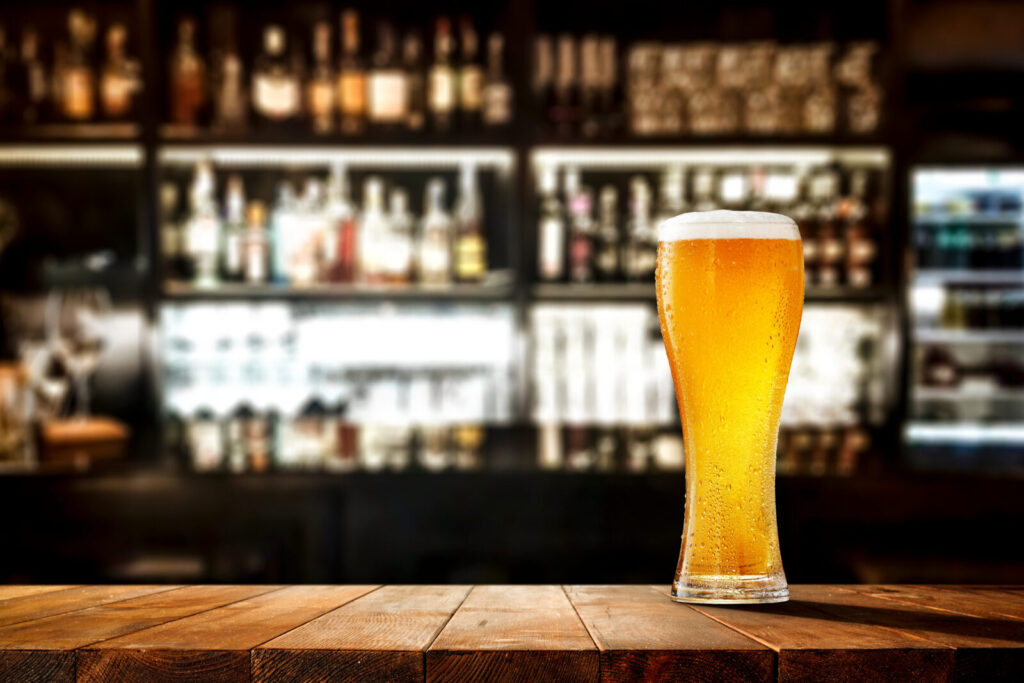Brief • 4 min Read

In The Harris Poll COVID-19 Tracker (Week 30) fielded September 17 – 19, 2020, we dive into the Fall with data and stories on streaming and whether Americans will continue their outdoor habits like dining and socializing as the winter ensues. We delve into whether brands should take political stands by backing specific candidates and look into how Americans discuss politics in 2020: by meme. Lastly, we examine the battered conventions and exhibits industry by surveying business customers on their likelihood to return to the floor and what it will take for them to feel safe.
As a public service, our team has curated key insights to help leaders navigate COVID-19. Full survey results, tables, and weekly summaries can be accessed for free at The Harris Poll COVID-19 Portal. We will continue to actively field on a regular cadence to track the shifts in sentiment and behaviors as the news and guidelines evolve.
Streaming Into Autumn
As COVID stretches into the fall, Americans are planning on streaming movies (49%) and tv shows (45%) that have been released but they haven’t seen yet. Here’s what else is happening in the stream que:
- Election 2020: More than 2 in 5 Americans (44%) plan on watching the election night results in November with (42%) planning to watch the fall Presidential debates. Both events ranked high in terms of what Americans are excited to watch.
- Brady the Buccaneer or LeBron the Laker? Despite LeBron James possibly on the verge of his tenth appearance in the NBA Finals – and first with the Los Angeles Lakers – a third (33%) of Americans plan on watching the NFL’s regular season compared to only a quarter (25%) planning to watch the NBA Finals. The World Series (23%) and Stanley Cup (14%) see slightly less enthusiasm.
- A New Era for Late Night: Since the pandemic, late night TV shows and other popular talk shows have repurposed shows in a virtual world with social distancing in mind, which is proving to be a success, Trevor Noah, reframed his show as ‘The Daily Social Distancing Show’ from his sofa in lieu of the usual Daily Show, and (40%) of Americans say they like the show even more now that it is virtual (especially men (46%), Gen X (49%), and Gen z/Millennials (45%). (40%) of Americans say the same for Last Week Tonight with John Oliver, Conan (38%), The Tonight Show Starring Jimmy Fallon (36%), The Lat Late Show with James Corden (36%), Jimmy Kimmel Live! (35%), SNL (34%), The Late Show with Stephan Colbert (34%).
- New battleground for streaming wars – price: In April our survey with the Wall Street Journal found a surging demand for streaming services right after COVID hit (30% of Americans reportedly bought Netflix subscription in March alone), but entertainment executives warned a recession could make it even tougher to persuade consumers to pay for subscriptions, but streaming prices continue to rise now diminishing its competitive stance as a cheaper alternative to the old cable television package…
Takeaway: Just two weeks ago, more than 3 in 5 Americans (63%) said they are coping with any stress and anxiety during COVID-19 by watching TV. And as colder weather approaches with the persistent threat of COVID, these feelings will likely only intensify, increasing the demand for streaming content that provides relief and is affordable.
Should Brands Be Political?
As more brands speak out on social issues, some find themselves ‘accidentally differentiated’ by politics. In August, Montauk Brewing displayed a chalkboard sign outside their tasting room supporting Black Lives Matter, only to face a community wide boycott. As the NY Post reported, Robert Frank, a police officer in Suffolk County, LI and his real estate agent wife Valeria Frank formed the Facebook group “Defund Montauk Brewing Company”. The group currently boasts nearly 30,000 Facebook followers.
Given that cautionary tale, we asked Americans this week about how far brands should go in being overtly political. Should a brand be red or blue or just stay out of the political fray entirely? Most Americans say the latter:
- There’s an even split on if brands and companies should endorse candidates: Like everything else that’s divided down the middle in America, nearly half (49%) of Americans agreed that companies and brands should endorse a specific candidate if they share the company’s values, but a slight majority (51%) disagreed.
- But young people want companies to take a stand: Nearly two-thirds (62%) of Gen Z/Millennials were in the pro-endorsement camp, showing a desire for more politically-active brands compared to (40%) of Boomers and (37%) of Seniors. (Apparently The Woodstock Generation now have McMansions and Bentleys).
- Big differences by party: (61%) of Democrats agree companies should publicly endorse political candidates, while (44%) of Republicans agreed. Independents most want companies to stay out of it: (41%) (59%) disagreed with brands endorsing candidates.
- Companies risk blowback: Two-thirds (65%) of Americans say they would be likely to boycott a company that took a strong political stand that they disagree with, including (67%) of Democrats and (69%) of Republicans. In a recent polling, we found (39%) said they were watching less NBA playoff games and the number one reason cited, (38%) said the league was becoming too political.
- Get in or stay out? In our August Harvard CAAPS/Harris Poll, (45%) said they would buy goods and services from a company that takes a public stance on social and political issues, while the majority (55%) think businesses should stay out. And two-thirds (66%) said they are being politically correct and not authentic.
- Why speak out? (79%) of Americans expect a company’s leadership to respond to COVID-19 and racial inequality and (81%) feel even if a company stumbles it’s important to see how they think and what their intentions are. Importantly here, both of these social issues were issues Americans roundly supported.
- Good intentions: The public increasingly assumes good intent from business, and often sees how they can impact that good behavior: (64%) agree that companies care about the well-being of their customers (+7% from 2017) and (63%) believe they can influence companies to do better by buying from them when they do (-2% from 2017).
Takeaway: So stay out of politics, right? Well, generally yes if you don’t want warring camps of boycotters and supporters among your customers. But the real answer is more nuanced: If positioning is the art of sacrifice, savvy brands are willing to engage with their core audiences at the expense of the general public to create greater engagement, especially among youth: Nike’s Colin Kaepernick ad had this effect in our polling. But ignoring social issues comes at a cost as well. (72%) of Americans said speaking out shows a company is living up to their internal values. Employees are often driving a firm to speak out and many CEO’s see their people as important, if not more than their customers.
Will We Come In From The Cold?
As much of the country shifted to accommodate new safety measures like outdoor dining during summer, we conducted polling to see what Americans will be comfortable with in the winter.
- Promise of the ‘bubble’: When thinking ahead of summer and being indoors more, Americans are most comfortable with socializing with friends and family indoors (72%). What can we learn from the NBA’s bubble strategy? Here’s the account of one reporter who spent 59 days in the NBA bubble.
- Getting used to the new normal: From half empty bars to hairdressers in face shields, the reopening of indoor businesses has been far from normal. But it seems Americans are becoming more comfortable living in the new normal (56%) say they would be comfortable going to a hair salon, shopping at a mall and eating at a restaurant this fall.
- The gym remains a scary place: Today, nearly 6 in 10 (57%) say they would not be comfortable going to the gym – showing little change from American sentiment in May when (83%) said they are more likely to exercise at home post COVID-19 than go to a local gym… Which might explain why Peloton’s Stock Rose Even as the Market Crashed, as reported in The Motley Fool.
- Meanwhile, concerns rise that Americans will let their guard down on safety precautions: Nearly 4 in 5 Americans (78%) are concerned people will start relaxing their stance on COVID-19 safety precautions this winter. Seniors are more likely than Gen Z/Millennials, Gen X and Boomers (86% vs. 78%, 76% and 75%). Democrats are more likely than Republicans (90% vs. 75%)
Takeaway: Americans are coming to terms that life will not be returning to the way it was anytime soon, signaling a slow departure from the flight or fight mode we were living under when COVID first hit. Consumers are adapting and finding new ways to socialize, work, travel, shop etc. which means business too must continually adapt their products and services to cater to the new agile consumer.
The Hidden Psychology of Political Memes
If you think political memes are ubiquitous this election year, you are likely correct. Last week, our exclusive poll with Fast Company found that more than half (55%) of Americans have shared a political meme in just the past three months.
- How can we tell it’s an election year? More than half (54%) are sharing more political memes on social media than they were a year ago, and one-fifth (21%) are sharing once a day or more often.
- It’s not just young Americans: While (72%) of those 18-34 have shared a political meme on social media in the past three months, (72%) of those Age 35-44, (54%) of those Age 45-54, and (45%) of those Age 55-64 have shared a political meme recently.
- However, it’s not always because we are trying to convince others: 4 in 10 (39%) say they are sharing the meme because they find it amusing. Just under half (46%) say it is to let people know where they stand, while (27%) share memes to change the minds of those who disagree and (24%) say it is to convince others their position is just.
- Facebook is the Battleground Platform: Among those that have shared a meme in the past three months, nearly all (90%) have shared a meme on Facebook, while two-thirds (66%) have shared on Instagram, three-fifths (59%) have shared on Twitter, (45%) have shared on Snapchat, and (39%) have shared on TikTok.
- The Meme Wars: With direct personal contact with voters limited because of the pandemic, campaigns are trying to reach voters by meme. Vox dives into the Biden campaign’s influencer strategy, noting “a host of other groups are also enlisting influencers and meme accounts to boost Democratic turnout in November.”
Takeaway: Love them or hate them, memes are increasingly an important way people – especially younger generations – communicate online. And it’s not just for politicians: winning over consumers by meme is an increasingly important part of every brand’s online strategy. Bud Light is even hiring a new type of “CMO”: Chief Meme Officer. However, simply because a new meme went viral isn’t an open invitation for brands: as one social media manager puts it: “It’s really easy for [Gen Z] to sense when a brand isn’t being authentic or trying too hard and [some brands will] miss the mark because they think ‘this thing is trending, I need to hop on it right now,’ even when the connection doesn’t make sense for them.”
Conventions: They’re No Longer Conventional
Since the pandemic struck Chicago six months ago, McCormick Place — the largest convention center in North America — has been a ghost town. Trade show associations and exhibitors across the country have been battered. We work with their industry association and our data says that attendance may never fully rebound, but most people who traveled to trade shows before the pandemic say they’ll be back.
- In a new Harris survey featured in the Chicago Tribune, a third of respondents (36%) say they’d be comfortable driving to an in-person event now and more than half (54%) if the convention site imposes risk-reducing requirements like face masks, temperature screening and social distancing.
- We also found that four in 10 (43%) said they had attended an in-person trade show, expo, conference or convention prior to the pandemic, with three-quarters (73%) saying they had gone to as many as five events in 2019.
- What attendees miss: Community (38%), networking (37%) and knowledge transfer (37%) are more important to business events since COVID as people are limited to virtual gatherings. Near the same amount (30%) say socializing is more important, and in a virtual world, people say experiences and engagement matter more (57%).
- Why trade shows matter: Based on economic impact studies by Choose Chicago, the city’s business-promotion council, the MPEA had projected that the greater McCormick Place would normally pump $2 billion into Chicago’s economy this year; it would also support more than 15,000 full-time jobs and fill an average of almost 4,000 downtown hotel rooms each and every night.
- That impact never materialized. Since mid-March, organizers have called off 150 gatherings including the International Manufacturing Technology Show, which had expected to bring 129,000 people to Chicago last week. The loss of tens of millions of dollars of tax revenue from these mass meetings is one reason the city’s budget deficit has swelled to $800 million this year and, with program cancellations already extending into 2021, could deepen to $1.2 billion next year.
- Asked when they’d feel comfortable driving to another city to attend an in-person trade show or convention — and this was without conditions such as having a widely available vaccine — 36% said immediately while (25%) said within six months. The numbers drop somewhat when asked about flying to such a mass meeting, to (14%) immediately and (26%) within six months.
- Generally, respondents said they prefer smaller gatherings. A quarter (24%) would be comfortable in a room with 50 people or fewer. Just as many, though, would be comfortable among 500 people or more. And interestingly, (16%) say they’d attend a trade show or conference if their bosses required them to. Still, (14%) said they would not feel comfortable attending any in-person event under any circumstances if they were permitted now.
- Here is a new trends presentation we gave to CEIR, the national conference industry yesterday as well as a strategy presentation featuring data on B2B customer attitudes toward attending events.
Takeaway: All return to conference industries relies on rapid testing and the success of Fall professional sports. Building trust in those face-to-face gatherings is vital: By a margin of 2 to 1, respondents prefer in-person events over virtual events because they’re better for such things as networking, socializing, new product tryouts and business leads. For now hybrid off and online models, local gatherings, smaller audiences, conference ‘bubble’s are the new norm.
Subscribe for more Insights
Subscribe to our newsletter for the latest trends in business, politics, culture, and more.
Download the Data
This survey was conducted online within the U.S. by The Harris Poll from September 17-19 among a nationally representative sample of 1,962 US. adults.
Download
Subscribe for more Insights
Subscribe to our newsletter for the latest trends in business, politics, culture, and more.
Download the Data
This survey was conducted online within the U.S. by The Harris Poll from September 17-19 among a nationally representative sample of 1,962 US. adults.
DownloadRelated Content








